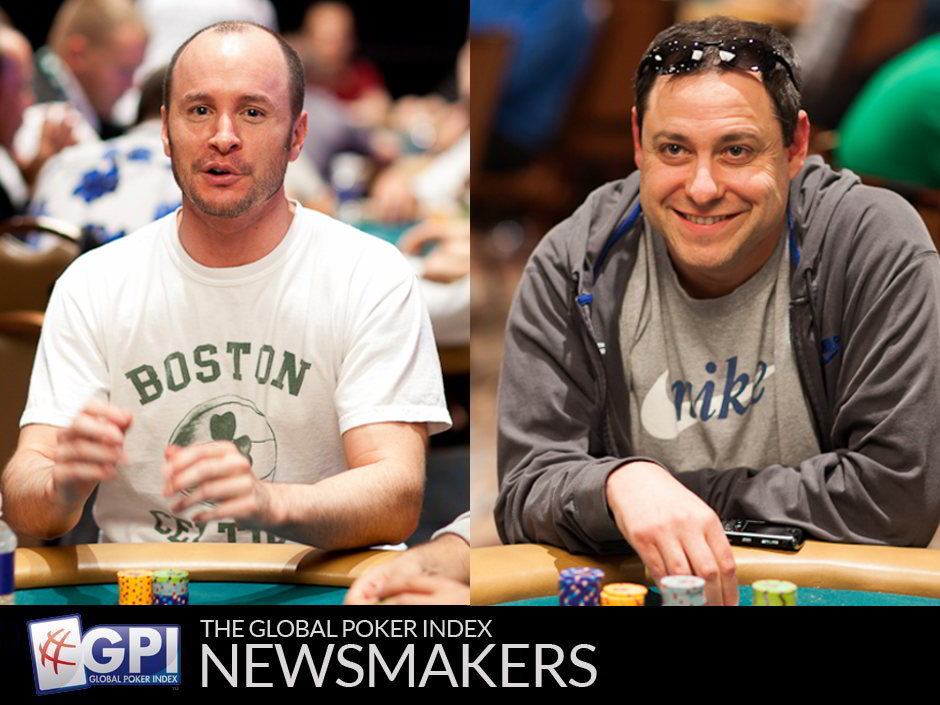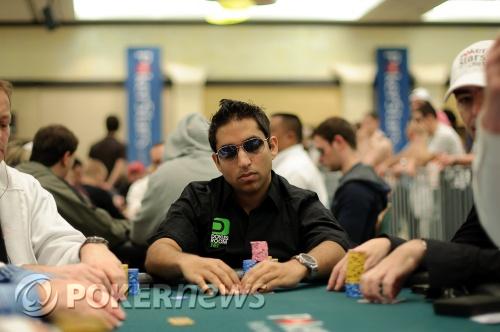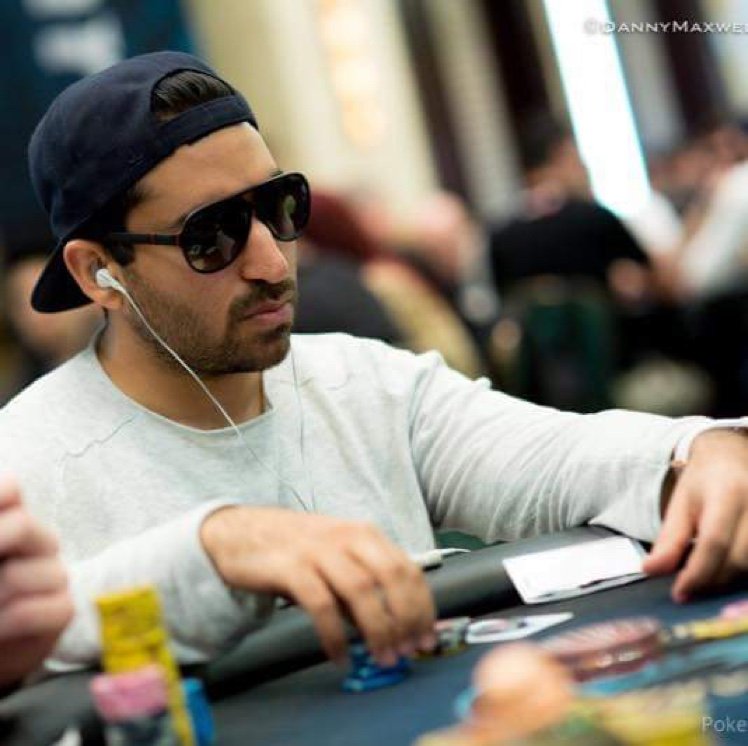On the last hand before his half of the room went on dinner break, Amit Makhija defends his big blind after the player on the button raises to 1,200. The flop falls 10c6s3s and both players check. The turn brings the 10s and Makhija bets 2,600. The player on the button raises to 7,000 total, and Makhija calls. Philip Stark raised to 36,000 on the button, and Ron Jenkins made the call from the small blind. Amit Makhija reraised to 110,000 from the big blind, and Stark got out of the way.

Poker run lake cumberland. Brunson 10 member Amit Makhija, also known as 'amak316' online, has been one of the most consistent online and live tournament players for the past three years with winnings exceeding $2.4 million. In every tournament he plays, there are ups and downs, and the best pros have to learn to play optimally with every kind of stack size, even a short one.
That brings us to this week's subject: Short-stack Tournament Strategy
First, let's talk about being short-stacked with some fold equity. If preflop raises are around 2.5 to 3.5 times the blinds, how many big blinds do you generally need to have to still have fold equity over an open raise?
It depends on the open raiser really. Against players that are really bad and don't have a good grasp of pot odds, you can definitely justify reshoving as short as 10 times the big blind. In general though, I like to have at least 15 times the big blind against competent players that you feel are opening light. People generally tend to find folds with moderate strength hands when they are getting less than 1.75-1 odds.
If you have enough fold equity, what types of hands do you prefer shoving with against players who you think are opening light and?
If I think their range is severely weighted to weak hands, the cards hardly matter if I can increase my stack by a considerable percentage by shoving. If I think they have a weaker than average range hand, but will still call me a fair percentage of the time, I tend to look for hands like small pairs, good broadway hands, and suited connectors because those types of hands play well enough versus the stronger hands in my opponents range that will call my reshove.
What about tighter open raisers who have a smaller range of raising hands but generally fold to three-bets? Do you need to polarize your range or should you not even shove bad hands against these types of players and just wait for a better spot?
Against weaker players, it's rarely a mistake to polarize ranges because they aren't thinking that way in general. They are just trying to put you on a specific hand. If you think their range is tight, but they are calling too tight, you can still consider reshoving light. But, in general, tight players are bad candidates for a resteal. There are definite situations to reshove on tight players that often arise in high buy-in tournaments in which people have satellited into and are playing with scared money. These players can sometimes find a fold with hands that are near the top of their range and can be good targets. Things like balancing ranges are only important against the best regulars that you play on a daily basis because they generally are the only people perceptive enough to realize it.
Joe pesci casino penna. Are there any other situations you are looking for when you have a 15 big blind stack?
A 15x stack is complicated to play at times. In general, I'm looking to reshove, but often it is a stack that you can profitably open shove. In the state of tournament poker today, everyone is looking to resteal against this stack, so when I have 15 times the big blind and there are a lot of tough regulars at my table, it becomes tough to open hands like small pairs, queen-jack suited, and weak suited aces, even in late position because these aren't necessarily hands you want to call off your entire tournament life on when you are faced with a resteal. The problem is these hands often figure to be the best hand at the table and folding these hands often makes you play entirely too tight. To combat this, a lot of good players in this situation these days are making larger than average open shoves with as much as 20 times the big blind.
To balance this, you also have to often shove your good hands against perceptive players. This has created an interesting dynamic in high buy-in online tournaments where regular players have been shoving a super wide range of hands. The variance in these tournaments is higher than it ever has been because of this dynamic.
That is an interesting dynamic. Does that maybe mean players are starting to consider themselves short-stacked earlier than in the past because they are able to open shove such a wide range?
People are certainly starting to think they are short-stacked earlier than before. It's pretty interesting to see how online tournaments have evolved over the years. We are beginning to see this evolution in live tournaments as well, but it will be years before they reach the state that online has because of the speed of online poker, it tends to evolve quickly.
What mistakes do you see players making with this sized stack?
The biggest mistake people make on that stack is opening too much and calling off too tight. A random player will often see hands like seven-eight suited, jack-ten suited, king-jack offsuit, ace-deuce through ace-nine, and other hands that look like they have a lot of value, then will get reshoved on and are forced to fold. They also will often raise hands like king-queen that probably have a lot of equity versus their opponents' reshoving range, and will still fold to the reshove because they think they can 'find better spots.'
Later this week, Makhija will also discuss playing an even shorter stack of 10 times the big blind, and also demonstrate how these concepts apply to an actual hand. While you're waiting, sign up for an online poker account and work on your game.
Tags
Poker Tournaments

Every Thursday, Card Player sits down with some of the best in the game to discuss pivotal hands from the week's biggest tournaments on the circuit.
This week, while covering the World Poker Tour Legends of Poker tournament at the Bicycle Casino, we spoke to final table chip leader Amit Makhija about the hand that gave him his lead. Makhija entered day 4 with a large stack already, but took advantage of a mistake made by an opponent to give him a massive lead on the rest of the field. It was a lead that proved to be insurmountable as Makhija used his chips to bully his tablemates before the final six were set.
Makhija plays online as AMAK316 and is no stranger to the grind that playing 10 tables on a Sunday can be. Makhija has earned more than $350,000 in Online Player of the Year-qualifying events alone. Having said that, he has already proven himself on the live circuit, as well, earning another $350,000 in the last year with more to come Thursday night. After going deep at the EPT Grand Final in Monte Carlo, Makhija followed that up with a final-table finish at the World Series of Poker. Tonight, he goes for his first WPT win.
| Event/Blinds-Antes | WPT Legends of Poker | 6,000-12,000 with a 2,000 ante |
| Player | Amit Makhija | Ron Jenkins |
| Chip Count | 850,000 | 750,000 |
| Hand | A J | 9 7 |
Philip Stark raised to 36,000 on the button, and Ron Jenkins made the call from the small blind. Amit Makhija reraised to 110,000 from the big blind, and Stark got out of the way.
Jenkins called, and the flop came down J 6 5. Jenkins led out for 120,000, and Makhija reraised to 260,000. Jenkins called.
The turn was the 5, pairing the board, and Jenkins moved all in for 380,000. Makhija, covering Jenkins by just 100,000, instantly called and tabled A,J. Jenkins showed 97 for a gutshot with a flush draw, and the river 9 wasn't enough for Jenkins.
Makhija took the pot and increased his stack to 1.65 million, a dominating lead at that time in the tournament.
The Interview
Julio Rodriguez: You repopped it from the big blind. Were you squeezing or just getting value from your hand?
Amit Makhija: Well, it was a squeeze, but I also knew my hand was good. The guy on the button [Philip Stark] had like 30 big blinds, and he was raising pretty wide. So, I thought by reraising from the big blind, I would call if he decided to shove. The other guy [Ron Jenkins] I hadposition on, and I figured he was flatting with any two cards. I'm holding A-J suited, and that is so far ahead of his range in that spot.
JR: What's your opinion of your opponent at this point?

AM: To be honest, he was kind of donkish. He was playing a lot of hands and playing them passively out of position. I kind of wanted him to call me, because we were both pretty deep at that point. I knew he was kind of looney and would stack off to me pretty light.

JR: He leads the flop for 120,000. Doesn't that seem like a kind of funky bet considering his action preflop?
AM: Uh, no. That's pretty normal for bad players. When they flop nothing, they try to lead in and take down pots because they don't want to risk too many chips with a check-raise. The problem with that thinking is that they have a hard time representing something big, because if they had a monster, they would check it hoping to get maximum value.

Poker run lake cumberland. Brunson 10 member Amit Makhija, also known as 'amak316' online, has been one of the most consistent online and live tournament players for the past three years with winnings exceeding $2.4 million. In every tournament he plays, there are ups and downs, and the best pros have to learn to play optimally with every kind of stack size, even a short one.
That brings us to this week's subject: Short-stack Tournament Strategy
First, let's talk about being short-stacked with some fold equity. If preflop raises are around 2.5 to 3.5 times the blinds, how many big blinds do you generally need to have to still have fold equity over an open raise?
It depends on the open raiser really. Against players that are really bad and don't have a good grasp of pot odds, you can definitely justify reshoving as short as 10 times the big blind. In general though, I like to have at least 15 times the big blind against competent players that you feel are opening light. People generally tend to find folds with moderate strength hands when they are getting less than 1.75-1 odds.
If you have enough fold equity, what types of hands do you prefer shoving with against players who you think are opening light and?
If I think their range is severely weighted to weak hands, the cards hardly matter if I can increase my stack by a considerable percentage by shoving. If I think they have a weaker than average range hand, but will still call me a fair percentage of the time, I tend to look for hands like small pairs, good broadway hands, and suited connectors because those types of hands play well enough versus the stronger hands in my opponents range that will call my reshove.
What about tighter open raisers who have a smaller range of raising hands but generally fold to three-bets? Do you need to polarize your range or should you not even shove bad hands against these types of players and just wait for a better spot?
Against weaker players, it's rarely a mistake to polarize ranges because they aren't thinking that way in general. They are just trying to put you on a specific hand. If you think their range is tight, but they are calling too tight, you can still consider reshoving light. But, in general, tight players are bad candidates for a resteal. There are definite situations to reshove on tight players that often arise in high buy-in tournaments in which people have satellited into and are playing with scared money. These players can sometimes find a fold with hands that are near the top of their range and can be good targets. Things like balancing ranges are only important against the best regulars that you play on a daily basis because they generally are the only people perceptive enough to realize it.
Joe pesci casino penna. Are there any other situations you are looking for when you have a 15 big blind stack?
A 15x stack is complicated to play at times. In general, I'm looking to reshove, but often it is a stack that you can profitably open shove. In the state of tournament poker today, everyone is looking to resteal against this stack, so when I have 15 times the big blind and there are a lot of tough regulars at my table, it becomes tough to open hands like small pairs, queen-jack suited, and weak suited aces, even in late position because these aren't necessarily hands you want to call off your entire tournament life on when you are faced with a resteal. The problem is these hands often figure to be the best hand at the table and folding these hands often makes you play entirely too tight. To combat this, a lot of good players in this situation these days are making larger than average open shoves with as much as 20 times the big blind.
To balance this, you also have to often shove your good hands against perceptive players. This has created an interesting dynamic in high buy-in online tournaments where regular players have been shoving a super wide range of hands. The variance in these tournaments is higher than it ever has been because of this dynamic.
That is an interesting dynamic. Does that maybe mean players are starting to consider themselves short-stacked earlier than in the past because they are able to open shove such a wide range?
People are certainly starting to think they are short-stacked earlier than before. It's pretty interesting to see how online tournaments have evolved over the years. We are beginning to see this evolution in live tournaments as well, but it will be years before they reach the state that online has because of the speed of online poker, it tends to evolve quickly.
What mistakes do you see players making with this sized stack?
The biggest mistake people make on that stack is opening too much and calling off too tight. A random player will often see hands like seven-eight suited, jack-ten suited, king-jack offsuit, ace-deuce through ace-nine, and other hands that look like they have a lot of value, then will get reshoved on and are forced to fold. They also will often raise hands like king-queen that probably have a lot of equity versus their opponents' reshoving range, and will still fold to the reshove because they think they can 'find better spots.'
Later this week, Makhija will also discuss playing an even shorter stack of 10 times the big blind, and also demonstrate how these concepts apply to an actual hand. While you're waiting, sign up for an online poker account and work on your game.
Tags
Poker Tournaments
Every Thursday, Card Player sits down with some of the best in the game to discuss pivotal hands from the week's biggest tournaments on the circuit.
This week, while covering the World Poker Tour Legends of Poker tournament at the Bicycle Casino, we spoke to final table chip leader Amit Makhija about the hand that gave him his lead. Makhija entered day 4 with a large stack already, but took advantage of a mistake made by an opponent to give him a massive lead on the rest of the field. It was a lead that proved to be insurmountable as Makhija used his chips to bully his tablemates before the final six were set.
Makhija plays online as AMAK316 and is no stranger to the grind that playing 10 tables on a Sunday can be. Makhija has earned more than $350,000 in Online Player of the Year-qualifying events alone. Having said that, he has already proven himself on the live circuit, as well, earning another $350,000 in the last year with more to come Thursday night. After going deep at the EPT Grand Final in Monte Carlo, Makhija followed that up with a final-table finish at the World Series of Poker. Tonight, he goes for his first WPT win.
| Event/Blinds-Antes | WPT Legends of Poker | 6,000-12,000 with a 2,000 ante |
| Player | Amit Makhija | Ron Jenkins |
| Chip Count | 850,000 | 750,000 |
| Hand | A J | 9 7 |
Philip Stark raised to 36,000 on the button, and Ron Jenkins made the call from the small blind. Amit Makhija reraised to 110,000 from the big blind, and Stark got out of the way.
Jenkins called, and the flop came down J 6 5. Jenkins led out for 120,000, and Makhija reraised to 260,000. Jenkins called.
The turn was the 5, pairing the board, and Jenkins moved all in for 380,000. Makhija, covering Jenkins by just 100,000, instantly called and tabled A,J. Jenkins showed 97 for a gutshot with a flush draw, and the river 9 wasn't enough for Jenkins.
Makhija took the pot and increased his stack to 1.65 million, a dominating lead at that time in the tournament.
The Interview
Julio Rodriguez: You repopped it from the big blind. Were you squeezing or just getting value from your hand?
Amit Makhija: Well, it was a squeeze, but I also knew my hand was good. The guy on the button [Philip Stark] had like 30 big blinds, and he was raising pretty wide. So, I thought by reraising from the big blind, I would call if he decided to shove. The other guy [Ron Jenkins] I hadposition on, and I figured he was flatting with any two cards. I'm holding A-J suited, and that is so far ahead of his range in that spot.
JR: What's your opinion of your opponent at this point?
AM: To be honest, he was kind of donkish. He was playing a lot of hands and playing them passively out of position. I kind of wanted him to call me, because we were both pretty deep at that point. I knew he was kind of looney and would stack off to me pretty light.
JR: He leads the flop for 120,000. Doesn't that seem like a kind of funky bet considering his action preflop?
AM: Uh, no. That's pretty normal for bad players. When they flop nothing, they try to lead in and take down pots because they don't want to risk too many chips with a check-raise. The problem with that thinking is that they have a hard time representing something big, because if they had a monster, they would check it hoping to get maximum value.
JR: What kind of hand were you putting him on?
AM: Taticas poker texas holdem rules. I figured he was just holding a weak draw, or maybe air, and I wanted to keep him in the pot, so I decided to raise pretty small. I made it 260,000, which was just over a min-raise.
JR: Do you think that your small reraise forced him to stay in the pot given how much he already had put in?
AM: No, he snap-called me. His chips went into the pot immediately after I raised. He snap-fired out and then snap-called my raise. I knew, at that point, that he had nothing and was planning something weird on the turn to try to take it away.
JR: Well, you were right. He open-shoved the turn.
AM: Yeah, he open-shoved [to put me all in] for about the other half of his stack. I didn't even have to think about it. I called, knowing I was way ahead. The turn paired the board with a five, but there's no way he's open-shoving trip fives there. The board wasn't exactly scary, so he'd probably try to get some value.
As it turns out, he picked up a diamond draw with his gutshot, but the way he bet the turn, it was almost as if the diamond draw was just a fortunate coincidence for his hand. I'm pretty sure that he would have shoved the turn even if he didn't pick up the extra outs. He looked like a pretty conservative guy, but I knew better because of a hand that Maria Ho told me about the day before that showed me that he likes to get out of line.
Amit Makhija Poker App
If I hadn't played with him before, it may have been a tougher spot for me. The entire day, he was making bets that just didn't make any sense. It was like he wanted to be aggressive but just didn't know how.
JR: Would you ever use his line for a situation like this?
AM: Not for this situation. If I were him, I would've moved all in on the flop, that way he might actually have shown a little strength. I was calling, anyway, but it would've been a bet that made much more sense.
I might use his line when I have a strong hand against players who don't know me and think I'm some random person. It looks really weak, and sometimes aggressive players will sense that.
JR: So, it's not too terrible of a line if you have a big hand?
AM: Exactly. He just did it backwards. [Laughing] He did it like every bad player does it … with a bad hand.
JR: If only you thought he was a good player, it would have worked perfectly.
AM: [Laughing] Probably not. I pretty much had the nuts on that flop.
